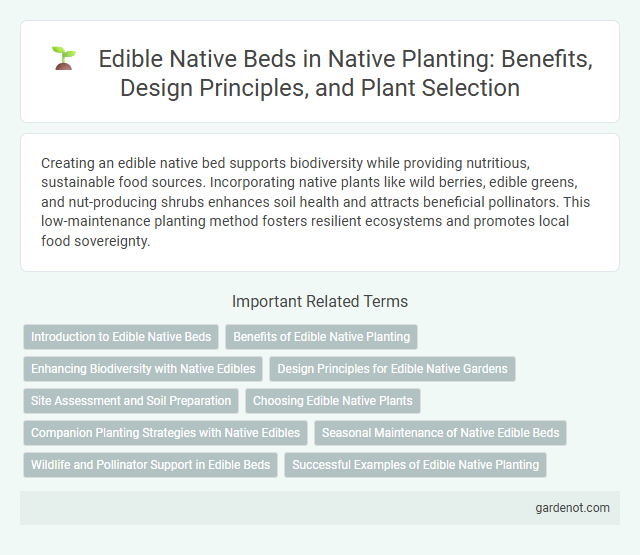Creating an edible native bed supports biodiversity while providing nutritious, sustainable food sources. Incorporating native plants like wild berries, edible greens, and nut-producing shrubs enhances soil health and attracts beneficial pollinators. This low-maintenance planting method fosters resilient ecosystems and promotes local food sovereignty.
Introduction to Edible Native Beds
Edible native beds cultivate indigenous plants that provide nutritious fruits, nuts, and greens naturally adapted to local soil and climate conditions. These gardens promote biodiversity, support pollinators, and require minimal maintenance compared to conventional gardens. Integrating edible native species enhances sustainable food production while preserving local ecosystems.
Benefits of Edible Native Planting
Edible native planting supports biodiversity by providing habitat and food sources for local pollinators and wildlife, enhancing ecosystem health. These plants are adapted to regional soil and climate conditions, requiring less water, fertilizer, and pesticides, which promotes sustainable gardening practices. Cultivating edible natives offers nutrient-rich produce with unique flavors, connecting gardeners to local heritage and traditional food sources.
Enhancing Biodiversity with Native Edibles
Edible native beds significantly enhance biodiversity by supporting local wildlife and pollinators through a variety of indigenous fruiting plants and herbs. Incorporating species such as elderberry, wild strawberries, and native mint enriches the ecosystem while providing sustainable food sources. These native edibles improve soil health and increase habitat complexity, fostering a balanced and resilient garden environment.
Design Principles for Edible Native Gardens
In designing edible native gardens, prioritize plant selection based on local adaptability, seasonal yield, and soil compatibility to ensure sustainable growth and minimal maintenance. Incorporate companion planting principles to enhance pest control, pollination, and nutrient cycling within the bed. Structure the garden with layered planting of ground covers, shrubs, and trees to maximize space and create microhabitats that support biodiversity and food production.
Site Assessment and Soil Preparation
Site assessment for an edible native bed involves analyzing sunlight exposure, soil texture, drainage, and existing vegetation to ensure optimal plant growth. Soil preparation requires amending the soil with organic matter like compost to enhance fertility, structure, and moisture retention, promoting healthy root development for native edible plants. Testing soil pH and nutrient levels guides tailored adjustments, fostering a thriving, sustainable native garden bed.
Choosing Edible Native Plants
Selecting edible native plants involves prioritizing species well-adapted to local climates and soils, such as wild strawberries (Fragaria virginiana) and elderberries (Sambucus canadensis), which thrive naturally and provide nutritious fruits. Incorporating nitrogen-fixing plants like groundnuts (Apios americana) supports soil fertility while offering a protein-rich harvest. Opting for a diverse mix of native edibles ensures resilience against pests and seasonal variations, promoting sustainable and productive garden beds.
Companion Planting Strategies with Native Edibles
Companion planting strategies in an edible native bed enhance plant health and yield by pairing species with complementary growth habits and nutrient needs, such as planting nitrogen-fixing natives like Lupinus alongside heavy feeders like Helianthus. Incorporating diverse native herbs, vegetables, and fruit-bearing plants encourages beneficial insect attraction and natural pest control, reducing the need for chemical inputs. Strategic layering of root depths and flowering periods in native edibles maximizes space efficiency and ecosystem resilience in sustainable garden design.
Seasonal Maintenance of Native Edible Beds
Seasonal maintenance of native edible beds involves timely pruning, mulching, and monitoring plant health to ensure optimal growth and productivity. Regular removal of dead foliage and invasive species prevents disease and supports nutrient cycling within the ecosystem. Adjusting irrigation according to seasonal rainfall patterns improves water efficiency and promotes resilient native edible plant development.
Wildlife and Pollinator Support in Edible Beds
Edible native beds provide essential habitats for wildlife by offering diverse food sources and shelter, promoting ecosystem balance. These beds attract a variety of pollinators such as bees, butterflies, and hummingbirds, which enhance pollination rates and improve crop yields. Incorporating native plants ensures resilience against pests and supports local biodiversity, making edible beds a sustainable choice for environmental health.
Successful Examples of Edible Native Planting
Successful edible native planting examples include the Three Sisters garden, which combines corn, beans, and squash to maximize space and nutrient sharing. The use of pawpaw trees and native berries, such as elderberries and serviceberries, creates diverse, sustainable food sources adapted to local ecosystems. Indigenous communities often integrate native herbs like wild onions and ramps, supporting both biodiversity and traditional culinary practices.
Edible native bed Infographic

 gardenot.com
gardenot.com